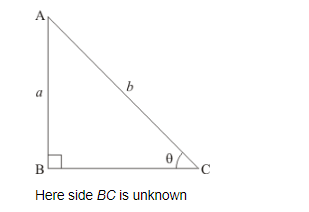If $\sin \theta=\frac{a}{b}$, find $\sec \theta+\tan \theta$ in terms of $a$ and $b$.
Given:
$\sin \theta=\frac{a}{b}$.....…… (1)
To find: $\sec \theta+\tan \theta$
Now we know, $\sin \theta$ is defined as follows
$\sin \theta=\frac{\text { Perpendicular side opposite to } \angle \theta}{\text { Hypotenuse }}$......(2)
Now by comparing (1) and (2)
We get,
Perpendicular side opposite to $\angle \theta=\mathrm{a}$
and
Hypotenuse = b
Therefore triangle representing angle $\theta$ is as shown below

Now we find side $B C$ by applying Pythagoras theorem to right angled $\triangle A B C$
Therefore,
$A C^{2}=A B^{2}+B C^{2}$
Now by substituting the value of sides AB and AC from figure (a)
We get,
$b^{2}=a^{2}+B C^{2}$
Therefore,
$B C^{2}=b^{2}-a^{2}$
Now by taking square root on both sides
We get,
$B C=\sqrt{b^{2}-a^{2}}$
Therefore,
Base side $B C=\sqrt{b^{2}-a^{2}}$......(3)
Now we know, $\cos \theta$ is defined as follows
$\cos \theta=\frac{\text { Base side adjacent to } \angle \theta}{\text { Hypotenuse }}$
Therefore from figure (a) and equation (3)
We get,
$\cos \theta=\frac{B C}{A C}$
$=\frac{\sqrt{b^{2}-a^{2}}}{b}$
$\cos \theta=\frac{\sqrt{b^{2}-a^{2}}}{b} \cdots \cdots$(4)
Now we know, $\sec \theta=\frac{1}{\cos \theta}$
Therefore,
$\sec \theta=\frac{1}{\frac{\sqrt{b^{2}-a^{2}}}{b}}$
Therefore,
$\sec \theta=\frac{b}{\sqrt{b^{2}-a^{2}}}$.....(5)
Now we know, $\tan \theta=\frac{\sin \theta}{\cos \theta}$
Now by substituting the values from equation (1) and (3)
We get,
$\tan \theta=\frac{\frac{a}{b}}{\frac{\sqrt{b^{2}-a^{2}}}{b}}$
$=\frac{a}{b} \times \frac{b}{\sqrt{b^{2}-a^{2}}}$
=\frac{a}{\sqrt{b^{2}-a^{2}}}
Therefore,
$\tan \theta=\frac{a}{\sqrt{b^{2}-a^{2}}}$.....(6)
Now we need to find $\sec \theta+\tan \theta$
Now by substituting the value of $\sec \theta$ and $\tan \theta$ from equation (5) and (6) respectively
We get,
$\sec \theta+\tan \theta=\frac{b}{\sqrt{b^{2}-a^{2}}}+\frac{a}{\sqrt{b^{2}-a^{2}}}$
$\sec \theta+\tan \theta=\frac{b+a}{\sqrt{b^{2}-a^{2}}} \ldots \ldots$(7)
Now we have the following formula which says
$x^{2}-y^{2}=(x+y) \times(x-y)$
Therefore by applying above formula in equation (7)
We get,
$\sec \theta+\tan \theta=\frac{b+a}{\sqrt{(b+a) \times(b-a)}}$
$=\frac{b+a}{\sqrt{(b+a)} \times \sqrt{(b-a)}}$
Now by substituting $(b+a)=\sqrt{(b+a)} \times \sqrt{(b+a)}$ in above expression
We get,
$\sec \theta+\tan \theta=\frac{\sqrt{(b+a)} \times \sqrt{(b+a)}}{\sqrt{(b+a)} \times \sqrt{(b-a)}}$
Now $\sqrt{(b+a)}$ present in the numerator as well as denominator of above expression gets cancels and we get,
$\sec \theta+\tan \theta=\frac{\sqrt{(b+a)}}{\sqrt{(b-a)}}$
Square root is present in the numerator as well as denominator of above expression
Therefore we can place both numerator as well as denominator under a common square root sign
Therefore, $\sec \theta+\tan \theta=\sqrt{\frac{b+a}{b-a}}$
Click here to get exam-ready with eSaral
For making your preparation journey smoother of JEE, NEET and Class 8 to 10, grab our app now.
